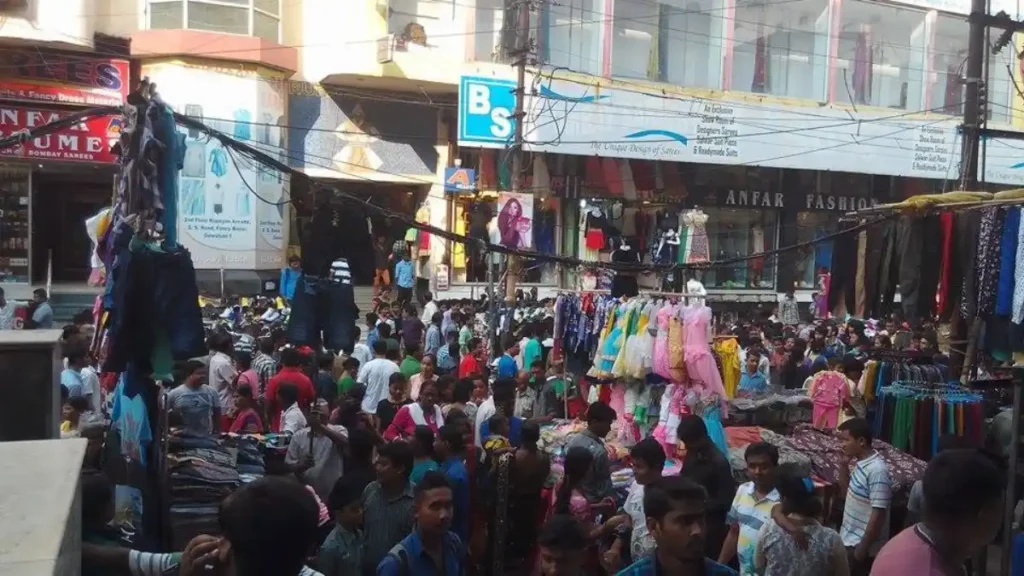Durga Puja preparations in Guwahati begin weeks before the first dhaak beats echo across the city. From the painstaking artistry of idol-making to the creativity of pandal themes, the entire city transforms into a vibrant canvas of devotion and celebration. Each year, Guwahati witnesses a blend of Assamese, Bengali, Marwari, Bihari, and other community efforts that bring the festival alive, turning preparations themselves into a cultural spectacle.
When Do Durga Puja Preparations Begin in Guwahati?
Preparations for Durga Puja in Guwahati often start months in advance. Community committees begin planning budgets, themes, and logistics right after Rath Yatra or Janmashtami. By the time Mahalaya arrives, artisans and volunteers are in full swing idols nearing completion, pandals taking shape, and markets buzzing with shoppers.
For many Guwahatians, Mahalaya signals that it’s time to get serious: committees finalize performers for cultural nights, sponsors tie up their branding plans, and families shop for new clothes. In short, the countdown for Durga Puja preparations in Guwahati begins long before the actual five days of Puja.
Idol-Making in Guwahati – Artisans at Work
One of the most soulful aspects of Durga Puja preparations in Guwahati is idol-making. Artisans, many of them descendants of generations of kumars (idol-makers), shape the Goddess with devotion and precision.
- Where it happens: Areas like Bishnupur, Pandu Bara Bazar (Maligaon), Amingaon, Athgaon, and a few other locations are known for idol workshops in Guwahati.
- How it’s done: The process starts with bamboo frameworks, followed by straw stuffing, clay application, and finally painting. Each idol takes weeks to complete, often with helpers working day and night.
- Chokkhu Daan: The most sacred ritual, the painting of Goddess Durga’s eyes, is done after Mahalaya, symbolizing that Maa has arrived on Earth.
- Challenges: Rising costs of clay, bamboo, and colors challenge artisans every year. Many committees now opt for eco-friendly idols using natural clay and organic paints to reduce pollution during immersion in the Brahmaputra.
For visitors, walking through these workshops before Puja is like stepping into the heartbeat of the festival.
Pandal Themes – Creativity Meets Culture
If idols embody devotion, pandals embody imagination. Committees across the city pour months of planning into creating pandals that are not just shelters for worship but art installations that narrate stories.
Here are some of the most talked-about Durga Puja pandal themes in Guwahati this year:
- Pandu – Pawns and Kings Theme: A chess-inspired pandal, symbolizing strategy, balance, and the power dynamics of life.
- Memory Lane (80s and 90s): Nostalgia-driven pandal recreating cassette tapes, vintage posters, and retro vibes.
- Rehabari Bilpar – Terracotta Theme: Crafted to highlight India’s clay artistry and heritage.
- 55-ft Hanuman-Themed Pandal: A towering installation celebrating devotion and mythology.
- Bishnupur – Hanging Gardens: A lush recreation of the world wonder, mixing greenery with eco-consciousness.
- Pandu Azad Hind Club – Child Rights Awareness: A socially conscious pandal focusing on children’s welfare and education.
- Athgaon – Women’s Empowerment Theme: A pandal dedicated to showcasing women’s strength and resilience.
Guwahati’s 2025 Pandal Highlights
| Location / Committee | Theme | Highlight |
|---|---|---|
| Pandu | Pawns and Kings | Chess-inspired artistry |
| Guwahati (central) | Memory Lane | Nostalgia of 80s & 90s |
| Rehabari Bilpar | Terracotta | Traditional clay artistry |
| Citywide | 55-ft Hanuman | Towering structure |
| Bishnupur | Hanging Gardens | Eco-friendly lush design |
| Pandu Azad Hind Club | Child Rights | Awareness through art |
| Athgaon | Women’s Empowerment | Social message theme |
These themes showcase how Durga Puja preparations in Guwahati mix devotion with culture, nostalgia, and social consciousness.
Behind the Scenes – The Role of Puja Committees
Durga Puja in Guwahati wouldn’t be possible without the hundreds of Puja committees that organize everything:
- Planning: Budgets, sponsors, and logistics often start rolling six months before Puja.
- Coordination: Artisans, electricians, decorators, and volunteers are hired.
- Events: Cultural nights, bhog distribution, and social awareness programs are scheduled.
- Safety: Fire services, police tie-ups, and medical booths are arranged.
For many residents, volunteering with a Durga Puja committee in Guwahati is a matter of pride and community service.
Local Markets & Shopping Rush

Preparations don’t just happen in pandals and workshops; they spill into Guwahati’s bustling markets, which become mini-festivals of their own.
- Fancy Bazar & Paltan Bazar: These two hubs turn into the beating heart of festive shopping. Families throng the lanes looking for new clothes, accessories, and home décor. Shops display traditional Assamese mekhela chadors alongside trendy kurtis, saris, and Indo-fusion wear. Jewelry shops do brisk business, while décor stalls showcase fairy lights, lanterns, and colorful torans that later find their way into pandals and homes.
- Maligaon & Beltola: Beyond fashion, these markets supply the raw materials for Puja itself. Bamboo, jute ropes, thermocol, and flowers arrive in truckloads. Artisans, electricians, and decorators source their essentials here. Beltola, especially known for fresh produce, becomes the go-to place for flowers and fruits used in rituals.
- Street Vendors: Durga Puja also means food memories. Vendors line the streets with ghugni, chops, jalebis, samosas, and jolmuri. The aroma of frying snacks mixes with the hum of bargaining crowds, creating a festive atmosphere even before pandals open.
Economically, Durga Puja is one of Guwahati’s biggest boosts of the year. Shopkeepers and small businesses often make a significant portion of their annual revenue in these few weeks. For rickshaw pullers, auto drivers, and temporary stall owners, it’s also a time of increased livelihood opportunities.
Eco-Friendly Moves in Guwahati’s Puja Preparations
Over the last few years, Durga Puja preparations in Guwahati have seen a strong shift toward sustainability, balancing devotion with environmental care.
- Eco-friendly idols: Instead of Plaster of Paris, committees are turning to natural clay, straw, and bamboo frameworks, painted with organic or vegetable-based colors. This ensures immersion in the Brahmaputra does not harm aquatic life.
- Plastic bans in pandals: Committees across neighborhoods are replacing plastic with cloth, paper, and biodegradable décor. Some even use bamboo art installations or terracotta backdrops to highlight local craft.
- Energy conservation: With thousands of pandals lit up, Guwahati has embraced LED lights and solar-powered displays to reduce electricity consumption. Some committees also run awareness campaigns about responsible energy use.
- Waste management: Awareness drives remind visitors not to litter. Dedicated bins and volunteer groups ensure that bhog plates, flowers, and plastics are disposed of responsibly. After visarjan, riverbanks are cleaned by joint teams of committees and civic bodies.
This shift reflects how Guwahati’s Puja spirit has matured, protecting tradition while adopting modern responsibility. Visitors now witness pandals that are not only artistic but also conscious of their environmental footprint.
Assam Government’s ₹10,000 Assistance to Puja Committees
At a programme held today at the office of the District Commissioner, Sivasagar, financial assistance of ₹10,000 each was disbursed to 93 Durga Puja committees. This initiative is part of the State Government’s support extended to 7,817 Puja committees across Assam during the… pic.twitter.com/BLnUm3x66F
— Ranoj Pegu (@ranojpeguassam) September 25, 2025
Like last year, the Government of Assam is extending a financial grant of ₹10,000 each to 7,817 Durga Puja Committees to enable the festival to be celebrated in a befitting manner. The funds have already been disbursed to the respective District Commissioners for onward…
— Himanta Biswa Sarma (@himantabiswa) September 24, 2025
Durga Puja 2025 in Guwahati has received a new boost from the Assam government, which has announced a financial assistance of ₹10,000 for every registered Puja committee. This step is meant to help local organizers manage the rising costs of decorations, lighting, bhog distribution, and safety arrangements.
For many small and mid-sized Puja committees, this support is significant. It allows them to invest in better facilities, hire artisans with fair wages, and ensure smoother crowd management. Larger committees welcome it too, using the assistance to strengthen eco-friendly measures like LED lighting and biodegradable décor.
Beyond money, the announcement is also seen as an acknowledgment of the cultural and economic importance of Durga Puja in Guwahati. With hundreds of committees working tirelessly, this gesture encourages inclusivity, ensuring even neighborhood-level Pujas have resources to celebrate Maa Durga with devotion and dignity.
How Guwahati Prepares Differently from Kolkata or Delhi
Though Durga Puja is celebrated across India, Guwahati’s Durga Puja preparations stand apart with their unique cultural mix and geographical setting.
- Blend of Cultures: Kolkata’s Puja is quintessentially Bengali, and Delhi’s is shaped by migrants. In Guwahati, however, Puja reflects a fusion of Assamese warmth and Bengali devotion. Assamese bhakti songs sometimes blend with Bengali dhak beats, creating a truly local soundscape. Committees may host Bihu dance one evening and Rabindra Sangeet the next, celebrating both traditions under one pandal.
- Riverfront Visarjan: While Kolkata immersions happen in the Hooghly, and Delhi uses lakes or artificial ponds, Guwahati’s immersion in the mighty Brahmaputra is spectacular. Processions move through city streets, converge at ghats, and end with the idols being gently lowered into the river, often against the backdrop of sunset. For many, this is the most emotional part of Puja.
- Community Focus: Kolkata pandals often aim for global attention and artistic competition. Guwahati pandals, while creative, maintain a neighborhood spirit with community members volunteering, local kids performing in cultural shows, and elders leading bhajans or naam-kirtans. Visitors feel part of a family gathering rather than just spectators at a show.
This makes Durga Puja preparations in Guwahati special, more intimate yet equally grand. It’s not just about spectacle; it’s about inclusivity, togetherness, and a cultural exchange that reflects the heart of Assam.
Conclusion
Durga Puja preparations in Guwahati 2025 are a vibrant journey in themselves. From the quiet corners where artisans shape clay into divinity to the grand pandals that showcase nostalgia, mythology, and social messages, the city’s devotion is expressed through creativity and hard work.
Markets, committees, and families together create a festive buzz that turns Guwahati into a cultural hub during Puja. Unlike anywhere else, here preparation itself feels like a celebration every bamboo tied, every idol painted, every pandal lit becomes part of the collective joy.
As the dhaak beats get closer and pandals open their doors, Guwahati stands ready not just to worship Maa Durga but to celebrate community, art, and togetherness. For anyone visiting, witnessing the Durga Puja preparations in Guwahati is as mesmerizing as the festival itself.
Frequently Asked Questions
Q. When do Durga Puja preparations start in Guwahati?
Preparations begin months in advance, often after Rath Yatra, but they peak after Mahalaya.
Q. Where are Durga Puja idols made in Guwahati?
Areas like Bishnupur, Pandu Bara Bazar (Maligaon), Amingaon, Athgaon, and a few other locations are known for idol workshops in Guwahati.
Q. What are the famous pandal themes in Guwahati 2025?
Themes include Pawns and Kings, Terracotta artistry, 80s & 90s nostalgia, a 55-ft Hanuman, Hanging Gardens, child rights, and women’s empowerment.
Q. How do Puja committees prepare for Durga Puja?
They plan budgets, hire artisans, organize cultural events, ensure safety, and coordinate bhog distribution for devotees.
